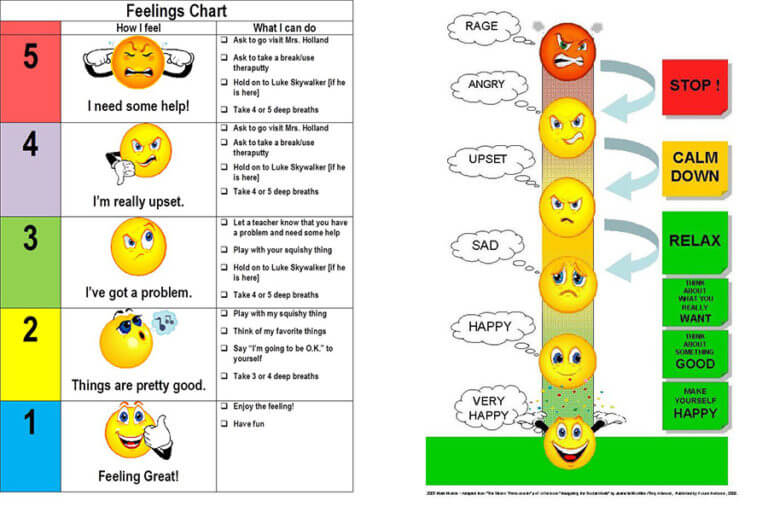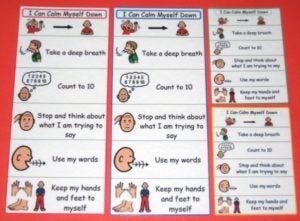By Jennifer H. Epstein
Most children who come to see me have a combination of developmental delays, communication challenges, and symptoms of anxiety, resulting in frequent tantrums.
It’s common for parents to share details about their daily struggles; the familiar patterns are that their children often have meltdowns during transitions, aggressive behaviors during tantrums, or panic-like symptoms in new or unexpected situations.
Over time, parents begin to worry about how they’ll manage these behaviors or what others will say or think. I often see a pattern develop where parents can anticipate when difficult behaviors will emerge for their children, and they try many different strategies to support their children, but sometimes they feel that what they’re doing is not helpful.
Why Do These Behaviors Occur in Fragile X Syndrome?
Let’s begin by talking about the neurobiology of Fragile X syndrome (FXS).
Based on brain studies, we now know that the brains are wired differently for individuals who have Fragile X syndrome, which leads to a situation of hyperarousal of the sympathetic nervous system. People with Fragile X syndrome tend to have trouble getting used to different sensory experiences.
For example, when they experience loud noises, crowded places, unexpected movement, visually distracting places, or strong smells, it can be overwhelming. Denser neural connections within a part of the brain called the amygdala — the integrative center for emotions and emotional behavior — also increase the likelihood of hyperarousal and anxiety.
Children with Fragile X syndrome tend to have maladaptive behaviors such as tantrums, screaming, trying to flee a situation, or panic, when their brains and bodies move into fear (fight or flight) following a triggering event. The hyperarousal leads to a disorganized state with decreased self-regulation, decreased access to language and communication, and reduced attention. Once this process begins, it can be hard to avoid an explosive outburst.
Strategies to Manage Anxiety
We try to use strategies that focus on preventing the escalation of anxiety and maladaptive behaviors by planning ahead and using strategies to keep children (and parents) remain calm.
1. Increase Structure and Predictability
We increase structure and predictability by creating practiced routines supported with visuals — e.g., pictures, visual schedules, checklists — to show a sequence of events.
There are a variety of apps that work well for this. One I like is called Choiceworks↗. It allows you to set up a visual schedule using their pictures or importing your own photos, so it’s easy to individualize. Additionally, you can check pictures off as you go so that it functions like a checklist. It can be used to show a sequence of events or to show steps to a task.
One family I know is using it to help with anxiety around going to the dentist. They set up a plan with their dentist to make repeated visits (one per month) so the child can follow the sequence while getting comfortable with the setting.
For this child, the hardest part is the dental exam. Before they get to that step, they’ll use the checklist to practice all the other steps, including a trip to the “prize box.” After he’s more comfortable, they can add in steps like Dentist will look into open mouth, Dentist will count teeth, and Dentist will brush teeth so he can learn the longer sequence without experiencing panic.
Similar pictures and steps can be used to practice teeth brushing or other self-help skills. (Also see Your Child’s Visit to the Dentist.)
2. Use Simpler Language
We decrease the length and complexity of the language we use with children with Fragile X syndrome. When children are feeling worried or experiencing anxiety, it’s harder for them to understand complex language. Unfortunately, in moments of frustration, parents sometimes talk more and give more directions, which tends to add to overstimulation and can intensify the likelihood of maladaptive behavior.
Instead, it’s helpful to use short phrases that are calming and have clear directives embedded within them. By relying on short phrases, children can quickly understand their meaning. By using predictable, practiced phrases, children know what to expect.
3. Teach Calming Routines
When practiced ahead of time, calming routines can interrupt the escalation of anxiety and overstimulation. Examples might be taking deep breaths, counting to five or 10, listening to a calming song, looking at a favorite picture or book, using fidget toys or stress balls, doing mindfulness exercises, holding yoga poses, pouring beans or rice, or playing in kinetic sand. (See: Kinetic Sand Recipe↗)
These are all strategies that when practiced in non-stressful situations can bring greater calmness during points of increasing anxiety. It can be very helpful to offer a familiar activity that has a calming influence and interrupt perseverative focus that can develop as anxiety.
Perseverative cognition is defined as “the repeated or chronic activation of the cognitive representation of one or more psychological stressors” (Brosschot, Gerin, & Thayer, 2006). Stressful events, or stressors, can make people “linger on” mentally. Humans, unlike animals, can make mental representations of stressors, long before and long after these events occur or are believed to occur. This continued cognitive representation of stressful events, before or after their occurrence, and even regardless of their actual occurrence, is called perseverative cognition. It can take the form of worry, rumination, angry brooding, etc., but also, for example, as mind wandering about negative topics. (View Source↗)
Once these strategies have been practiced in calm moments, they can be offered as a regular part of the overall daily schedule, and prior to a transition or other known triggering event.
Your child may benefit from working with an occupational therapist at school or in private consultation to work on calming strategies as part of their overall sensory processing program.
4. Identify and Express Feeling States
We teach identification and appropriate expression of feeling states.
feeling state: Affect is the collective term for describing feeling states like emotions and moods. Affective states may vary in several ways, including their duration, intensity, specificity, pleasantness, and level of arousal, and they have an important role to play in regulating cognition, behavior, and social interactions. (View Source↗)
Children can point to pictures to show how they are feeling. They can learn short words to associate with feeling states (mad, sad, worried, scared). The Incredible 5-Point Scale↗ by Kari Dunn Buron uses visuals and allows children to reference how they are feeling, regardless of delays in expressive communication skills. A child can point to show what they are experiencing on a feeling thermometer, and a parent can help the child to use strategies to return to a calmer state.
Here are some examples made for a child who moved into a tantrum each time he experienced too much frustration.

 5. The Calm Down Book
5. The Calm Down Book
At past International Fragile X conferences, I have demonstrated the use of a flip book — the Calm Down Book — that teaches a sequence of calming exercises using deep breathing and modified progressive relaxation with pictures. If you would like a copy of it, please feel free to email me.
Where to Begin
These ideas need to be individualized for your child. It is important to keep in mind what you already know about your child. Try to work with a friend to make a list of what are likely triggers for panic and anxiety that result in tantrums.
- Pay attention to patterns when your child starts to perseverate or repeat ideas in a way that makes you feel they’re anxious rather than excited.
- Pay attention to their body language. Kids will often try to hide, chew more, cover their ears, or leave a situation that is overwhelming. Flushing is a common reaction when feeling anxious.
- Pay attention to what you already know about your child’s likes, what helps them calm down, and what objects and activities provide good distractions.
- Model use of feeling words and begin to introduce feeling pictures.
- Practice taking a big breath, counting, or using positive self-talk before major transitions so that your child sees you using the same strategies you want your child to use.
- Consider making a video of one of your child’s older siblings or a peer using the strategy you want your child to use.
- Pay attention to the words you use. Help your child to focus on something they like that’s happening in the present moment rather than offering reassurance about a future event.
- Add one piece at a time, this way it’s possible to build skills in the areas of self-regulation and calming strategies.
Additional Resources
Growing Up Brave: Expert Strategies for Helping Your Child Overcome Fear, Stress, and Anxiety↗ by Donna B. Pincus
About

Jennifer Epstein
Dr. Epstein is a licensed clinical psychologist and health service provider with more than 20 years of experience working with children and families. Dr. Epstein specializes in treatment of neurodevelopmental disorders including delays in development, autism spectrum disorders, and genetic disorders such as Fragile x syndrome. She is a certified Early Start Denver Model Trainer.

